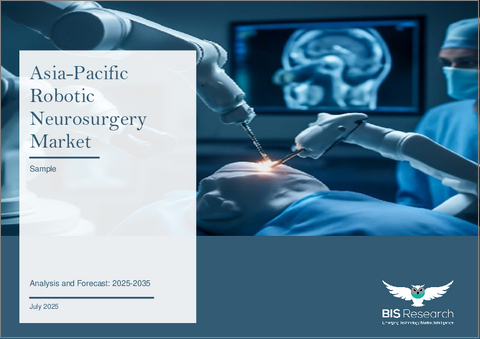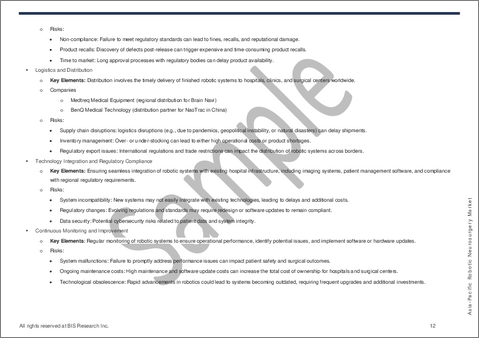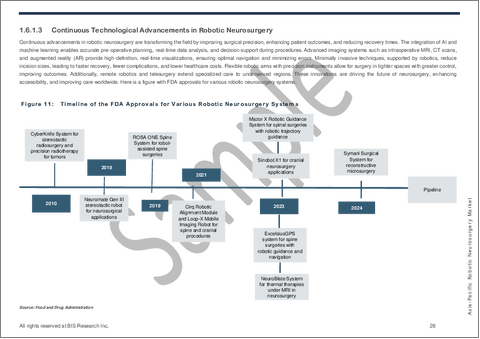|
|
市場調査レポート
商品コード
1781121
アジア太平洋地域のロボット神経外科市場:分析・予測 (2025-2035年)Asia-Pacific Robotic Neurosurgery Market: Analysis and Forecast, 2025-2035 |
||||||
カスタマイズ可能
|
|||||||
| アジア太平洋地域のロボット神経外科市場:分析・予測 (2025-2035年) |
|
出版日: 2025年07月31日
発行: BIS Research
ページ情報: 英文 71 Pages
納期: 1~5営業日
|
全表示
- 概要
- 図表
- 目次
アジア太平洋地域のロボット神経外科の市場規模は、2025年の9,260万ドルから、予測期間中は20.28%のCAGRで推移し、2035年には5億8,700万ドルに達すると予測されています。
同地域における神経疾患の有病率の上昇が、ロボット神経外科の拡大を後押ししており、高度で正確な外科手術技術への需要を高めています。AIの統合、リアルタイム画像技術、精度の向上といった技術革新により、手術結果は大きく改善され、手術手技の可能性も広がっています。
| 主要市場統計 | |
|---|---|
| 予測期間 | 2025-2035年 |
| 2025年評価 | 9,260万米ドル |
| 2035年予測 | 5億8,700万米ドル |
| CAGR | 20.28% |
低侵襲手術の人気が高まっていることも、ロボット神経外科の導入をさらに加速させています。これらの手術は、患者の手術リスクと回復期間を短縮できるためです。さらに、新興国を中心とした地域の医療インフラの急速な整備が、導入に適した環境を生み出しています。また、地域企業と国際企業の間で戦略的パートナーシップが進展し、研究開発投資が増加していることで、技術革新が促進され、市場へのアクセスも拡大しています。こうした背景により、ロボット神経外科は同地域で重要な成長分野となっています。
同地域のロボット神経外科市場は、地域内で最も急速に成長している手術ロボット分野の一つとして浮上しています。脳腫瘍、てんかん、パーキンソン病などの神経疾患の増加に伴い、高度で高精度な外科手術のニーズが高まっています。先進国・新興国を問わず、地域の医療従事者にとって、ロボット神経外科は高い精度、低侵襲性。患者の治療結果の改善という利点から、魅力的な選択肢となっています。
AIの統合、リアルタイム画像処理、触覚フィードバックデバイスなど、術者に対する操作性と可視化能力を向上させる技術開発が、神経外科手術の在り方を大きく変えつつあります。また、回復期間の短縮、合併症の減少、入院期間の短縮といった利点により、低侵襲手術への移行が進んでいることも、ロボットシステムの導入を後押ししています。
特に中国、インド、東南アジアといった新興国では、医療インフラへの投資が進んでおり、政府の支援策や民間セクターによる技術革新の高まりによって、市場浸透が加速しています。さらに、地域のニーズに合った低価格のロボットシステムを地元企業が開発しており、先進的な神経外科治療へのアクセス向上に貢献しています。臨床応用の拡大や、より有利な償還制度の整備により、アジア太平洋地域のロボット神経外科市場は今後も長期的に大きな成長が見込まれています。
市場の分類:
セグメンテーション1:製品タイプ別
- ロボットシステム
- サービス
- 器具とアクセサリー
セグメンテーション2:地域別
- 中国
- 日本
- インド
- 韓国
- オーストラリア
- その他
当レポートでは、アジア太平洋地域のロボット神経外科の市場を調査し、主要動向、市場影響因子の分析、法規制環境、技術・特許の分析、市場規模の推移・予測、各種区分・地域/主要国別の詳細分析、競合情勢、主要企業のプロファイルなどをまとめています。
目次
エグゼクティブサマリー
範囲と定義
第1章 ロボット神経外科市場:業界展望
- 動向:現状と将来への影響評価
- ロボット神経外科手術の導入増加
- 企業間の多数のコラボレーション
- 製品発売と規制承認の増加
- サプライチェーンの概要
- 規制の枠組み
- 日本
- 中国
- 価格分析
- ケーススタディ:Brain NaviのNaoTracが脳神経外科手術100件を達成
- 資金調達シナリオ
- 市場力学
- 市場促進要因
- 市場抑制要因
- 市場機会
第2章 ロボット神経外科市場:地域別
- 地域サマリー
- アジア太平洋
- 地域概要
- 市場成長の原動力
- 市場課題
- 処置件数
- 中国
- 日本
- インド
- オーストラリア
- 韓国
- その他
第3章 市場:競合ベンチマーキングと企業プロファイル
- 製品ベンチマーク
- 主要戦略と開発
- 企業プロファイル
- KUKA AG (Midea Group)
- Beijing Baihui Weikang Technology Co., Ltd.
- Brain Navi Biotechnology Co. Ltd
- Beijing Tinavi Medical Technologies Co., Ltd.
第4章 調査手法
List of Figures
- Figure 1: Asia-Pacific Robotic Neurosurgery Market (by Scenario), $Million, 2024, 2028, and 2035
- Figure 2: Asia-Pacific Robotic Neurosurgery Market (by Product Type), $Million, 2023, 2028, and 2035
- Figure 3: Supply Chain and Risks within the Supply Chain
- Figure 4: Japan Federation of Medical Devices Associations (JFMDA) Classification
- Figure 5: NMPA Classification
- Figure 6: Robotic Neurosurgery Market, Patent Analysis (by Year), January 2019-April 2025
- Figure 7: Impact Analysis of Market Navigating Factors, 2024-2035
- Figure 8: Incidences of Neurological Disorders, Thousands, 2018-2021
- Figure 9: Prevalence of Neurological Disorders (by Type of Neurological Disease), Thousands, 1990-2019
- Figure 10: Prevalence of Parkinson's Disease, Region (2016-2021)
- Figure 11: Timeline of the FDA Approvals for Various Robotic Neurosurgery Systems
- Figure 12: Asia-Pacific Robotic Neurosurgery Market, Procedure Volume, 2023-2035
- Figure 13: Asia-Pacific Robotic Neurosurgery Market, $Million, 2023-2035
- Figure 14: Asia-Pacific Robotic Neurosurgery Market, Installed Base, 2023-2035
- Figure 15: Asia-Pacific Robotic Neurosurgery Market, Unit Sold, 2023-2035
- Figure 16: Incidences of Neurological Disorders in China, 2018-2021
- Figure 17: China Robotic Neurosurgery Market, Procedure Volume, 2023-2035
- Figure 18: China Robotic Neurosurgery Market, $Million, 2023-2035
- Figure 19: Incidences of Neurological Disorders in Japan, 2018-2021
- Figure 20: Japan Robotic Neurosurgery Market, Procedure Volume, 2023-2035
- Figure 21: Japan Robotic Neurosurgery Market, $Million, 2023-2035
- Figure 22: Incidences of Neurological Disorders in India, 2018-2021
- Figure 23: India Robotic Neurosurgery Market, Procedure Volume, 2023-2035
- Figure 24: India Robotic Neurosurgery Market, $Million, 2023-2035
- Figure 25: Incidences of Neurological Disorders in Australia, 2018-2021
- Figure 26: Australia Robotic Neurosurgery Market, Procedure Volume, 2023-2035
- Figure 27: Australia Robotic Neurosurgery Market, $Million, 2023-2035
- Figure 28: Incidences of Neurological Disorders in South Korea, 2018-2021
- Figure 29: South Korea Robotic Neurosurgery Market, Procedure Volume, 2023-2035
- Figure 30: South Korea Robotic Neurosurgery Market, $Million, 2023-2035
- Figure 31: Rest-of-Asia-Pacific Robotic Neurosurgery Market, Procedure Volume, 2023-2035
- Figure 32: Rest-of-Asia-Pacific Robotic Neurosurgery Market, $Million, 2023-2035
- Figure 33: Strategic Initiatives, January 2022-April 2025
- Figure 34: Data Triangulation
- Figure 35: Top-Down and Bottom-Up Approach
- Figure 36: Assumptions and Limitations
List of Tables
- Table 1: Market Snapshot
- Table 2: Competitive Landscape Snapshot
- Table 3: Robotic Neurosurgery Market Trend Analysis
- Table 4: Some of the Partnerships and Collaborations in the Robotic Neurosurgery Market
- Table 5: Some of the Product Launch and Regulatory Approvals in the Robotic Neurosurgery Market
- Table 6: Medical Devices in Japan
- Table 7: Costs of Neurosurgery Robotic Systems
- Table 8: Funding Scenario of Neurosurgery Robotic Systems
- Table 9: Comparison of Robotic Neurosurgical Procedures Over Conventional Open Surgical Procedures
- Table 10: Comparison Between Various Navigation Systems Cost Breakdown of Robotic Neurosurgery Systems
- Table 11: Robotic Neurosurgery Market (by Region), $Million, 2023-2035
- Table 12: Asia-Pacific Robotic Neurosurgery Market (by Product Type), $Million, 2023-2035
- Table 13: Incidences of Neurological Disorders in China, By Disease Type, 2018-2021
- Table 14: Incidences of Neurological Disorders in Japan, By Disease Type, 2018-2021
- Table 15: Incidences of Neurological Disorders in India, By Disease Type, 2018-2021
- Table 16: Incidences of Neurological Disorders in Australia, By Disease Type, 2018-2021
- Table 17: Incidences of Neurological Disorders in South Korea, By Disease Type, 2018-2021
- Table 18: Robotic Neurosurgery Market, Product Benchmarking (by Product)
- Table 19: Key Strategies, January 2022-April 2025
This report can be delivered in 2 working days.
Introduction to Asia-Pacific Robotic Neurosurgery Market
The Asia-Pacific robotic neurosurgery market is projected to reach $587.0 million in 2035 and estimated $92.6 million in 2025, growing at a CAGR of 20.28% during the forecast period 2025-2035. The rising prevalence of neurological conditions in the APAC area is fuelling the expansion of robotic neurosurgery and raising the need for sophisticated and accurate surgical techniques. Technological developments are greatly enhancing surgical results and increasing procedural capabilities. Examples of these developments include AI integration, real-time imaging, and improved precision.
| KEY MARKET STATISTICS | |
|---|---|
| Forecast Period | 2025 - 2035 |
| 2025 Evaluation | $92.6 Million |
| 2035 Forecast | $587.0 Million |
| CAGR | 20.28% |
The increasing popularity of minimally invasive procedures is speeding up adoption even more because they lower surgical risks and recuperation periods for patients. Additionally, a favourable deployment environment is being created by the rapid expansion of healthcare infrastructure throughout emerging APAC markets. Furthermore, increasing R&D expenditures and strategic partnerships between regional and international businesses are stimulating innovation and expanding market accessibility, making robotic neurosurgery a vital area of expansion in the healthcare sector in Asia-Pacific.
Market Introduction
The Asia-Pacific (APAC) robotic neurosurgery industry is emerging as one of the region's fastest-growing surgical robotics segments. The need for sophisticated, high-precision surgical procedures is growing as neurological conditions like brain tumours, epilepsy, and Parkinson's disease become more common. Healthcare professionals in both established and developing APAC nations find robotic neurosurgery to be a tempting alternative due to its increased accuracy, decreased invasiveness, and improved patient outcomes.
Technological developments that provide surgeons more control and visualisation, such as the incorporation of artificial intelligence, real-time imaging, and haptic feedback devices, are transforming neurosurgery procedures. The deployment of robotic systems is being further fuelled by the region's trend towards minimally invasive surgeries, which have advantages like quicker recovery times, less problems, and shorter hospital stays.
Market penetration is being accelerated by rising investments in healthcare infrastructure, especially in developing nations like China, India, and Southeast Asia, as well as encouraging government programs and rising private-sector innovation. Furthermore, local producers are creating affordable robotic systems that are suited to local requirements, increasing access to cutting-edge neurosurgical treatment. The market for robotic neurosurgery in APAC is expected to increase significantly over the long run due to expanding clinical applications and better reimbursement regulations.
Market Segmentation
Segmentation 1: by Product Type
- Robotic Systems
- Services
- Instruments and Accessories
Segmentation 2: by Region
- China
- Japan
- India
- South Korea
- Australia
- Rest-of-Asia-Pacific
APAC Robotic Neurosurgery Market Trends, Drivers and Challenges
Market Trends
- APAC is the fastest-growing region in the global robotic neurosurgery market, with a strong CAGR projection.
- Increasing adoption of robotic neurosurgery in ambulatory surgical centers and specialty clinics.
- Surge in domestic robotic system development by regional players, leading to more affordable solutions.
- Growing demand for minimally invasive and AI-integrated neurosurgical procedures.
- Broader procedural applications such as spinal surgeries, brain tumor removal, and deep brain stimulation.
Key Drivers
- Rising prevalence of neurological disorders like stroke, brain tumors, and Parkinson's disease.
- Expanding healthcare infrastructure and increasing healthcare investments across APAC.
- Advancements in surgical robotics, including improved imaging, navigation, and AI-powered systems.
- Cost-effective robotic systems developed by regional players expanding accessibility.
- Increasing number of trained neurosurgeons and improved medical education frameworks.
Major Challenges
- High capital investment and maintenance costs limit adoption, especially in smaller hospitals.
- Limited or inconsistent reimbursement policies across APAC countries.
- Shortage of skilled professionals trained in robotic neurosurgery.
- Complex and fragmented regulatory pathways across different countries in the region.
- Rapid technological evolution creates pressure for frequent system upgrades.
- Safety, ethical, and liability concerns related to robotic-assisted surgeries.
How can this report add value to an organization?
Product/Innovation Strategy: The APAC robotic neurosurgery market has been extensively segmented based on various categories, such as product type, and region. This can help readers get a clear overview of which segments account for the largest share and which ones are well-positioned to grow in the coming years.
Competitive Strategy: The APAC robotic neurosurgery market has numerous established players with product and service portfolios. Key players in the APAC robotic neurosurgery market, as analyzed and profiled in the study, include established companies offering robotic neurosurgery systems, instruments, accessories, and services.
Key Market Players and Competition Synopsis
The companies that are profiled have been selected based on inputs gathered from primary experts and analyzing company coverage, type portfolio, and market penetration.
Some prominent names in the market include:
- KUKA AG (Midea Group)
- Beijing Baihui Weikang Technology Co., Ltd.
- Brain Navi Biotechnology Co. Ltd
- Beijing Tinavi Medical Technologies Co., Ltd.
Table of Contents
Executive Summary
Scope and Definition
1 Robotic Neurosurgery Market: Industry Outlook
- 1.1 Trends: Current and Future Impact Assessment
- 1.1.1 Increasing Adoption of Robotic Neurosurgery Procedures
- 1.1.2 Significant Number of Collaborations among Market Players
- 1.1.3 Growing Number of Product Launch and Regulatory Approvals
- 1.2 Supply Chain Overview
- 1.3 Regulatory Framework
- 1.3.1 Japan
- 1.3.2 China
- 1.4 Pricing Analysis
- 1.4.1 Case Study: Brain Navi's NaoTrac Reaches 100 Neurosurgical Procedures Milestone
- 1.5 Funding Scenario
- 1.6 Market Dynamics
- 1.6.1 Market Drivers
- 1.6.1.1 Advantages of Robotic Neurosurgical Procedures Over Conventional Open Surgical Procedures
- 1.6.1.2 Rising Prevalence of Neurological Disorders
- 1.6.1.3 Continuous Technological Advancements in Robotic Neurosurgery
- 1.6.2 Market Restraints
- 1.6.2.1 High Cost of Investment
- 1.6.2.2 Lack of Skilled Professionals
- 1.6.3 Market Opportunities
- 1.6.3.1 Development of Long-Distance Teleoperated Surgical Robotic Systems
- 1.6.1 Market Drivers
2 Robotic Neurosurgery Market (by Region), $Million, 2023-2035
- 2.1 Regional Summary
- 2.2 Asia-Pacific
- 2.2.1 Regional Overview
- 2.2.2 Driving Factors for Market Growth
- 2.2.3 Factors Challenging the Market
- 2.2.4 Procedure Volume
- 2.2.5 China
- 2.2.6 Japan
- 2.2.7 India
- 2.2.8 Australia
- 2.2.9 South Korea
- 2.2.10 Rest-of-Asia-Pacific
3 Markets - Competitive Benchmarking & Company Profiles
- 3.1 Product Benchmarking
- 3.2 Key Strategies and Development
- 3.3 Company Profiles
- 3.3.1 KUKA AG (Midea Group)
- 3.3.1.1 Overview
- 3.3.1.2 Top Products/Product Portfolio
- 3.3.1.3 Top Competitors
- 3.3.1.4 Target Customers
- 3.3.1.5 Key Personal
- 3.3.1.6 Analyst View
- 3.3.2 Beijing Baihui Weikang Technology Co., Ltd.
- 3.3.2.1 Overview
- 3.3.2.2 Top Products/Product Portfolio
- 3.3.2.3 Top Competitors
- 3.3.2.4 Target Customers
- 3.3.2.5 Key Personal
- 3.3.2.6 Analyst View
- 3.3.3 Brain Navi Biotechnology Co. Ltd
- 3.3.3.1 Overview
- 3.3.3.2 Top Products/Product Portfolio
- 3.3.3.3 Top Competitors
- 3.3.3.4 Target Customers
- 3.3.3.5 Key Personal
- 3.3.3.6 Analyst View
- 3.3.4 Beijing Tinavi Medical Technologies Co., Ltd.
- 3.3.4.1 Overview
- 3.3.4.2 Top Products/Product Portfolio
- 3.3.4.3 Top Competitors
- 3.3.4.4 Target Customers
- 3.3.4.5 Key Personal
- 3.3.4.6 Analyst View
- 3.3.1 KUKA AG (Midea Group)
4 Research Methodology
- 4.1 Data Sources
- 4.1.1 Primary Data Sources
- 4.1.2 Secondary Data Sources
- 4.1.3 Data Triangulation
- 4.2 Market Estimation and Forecast





